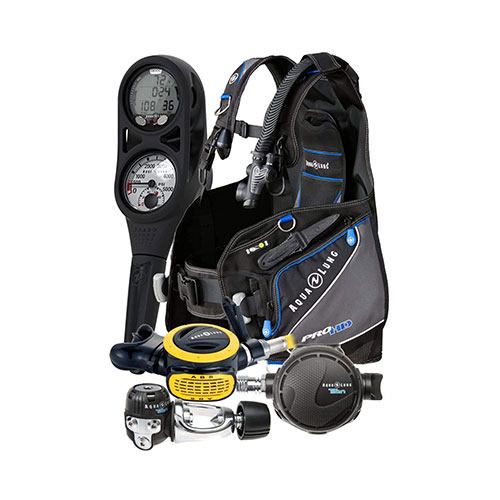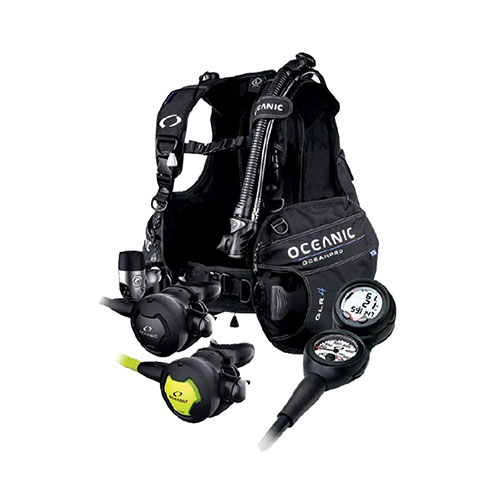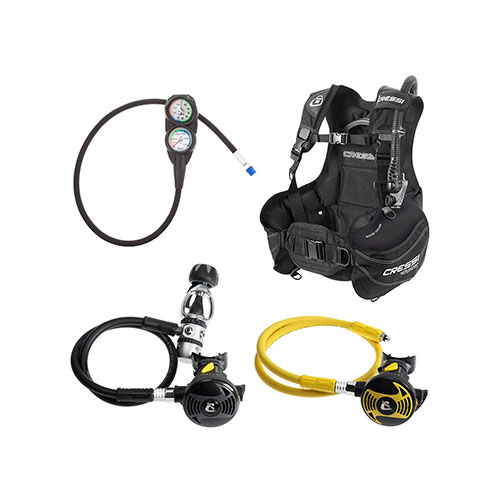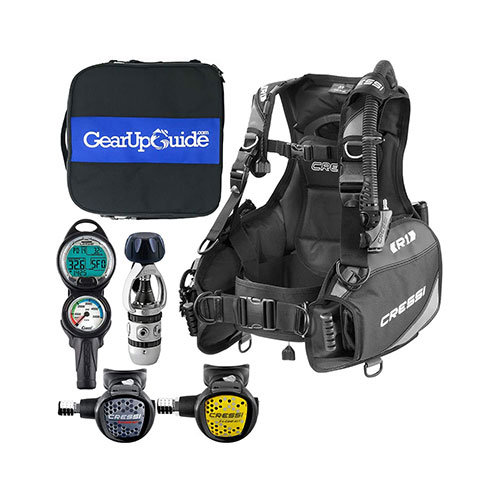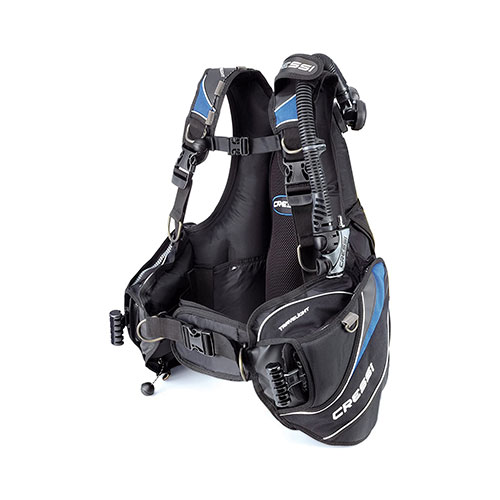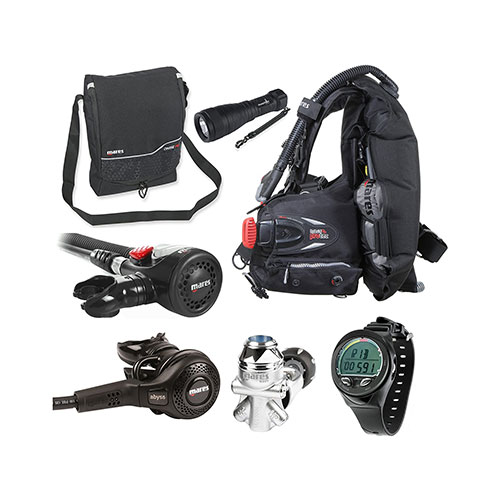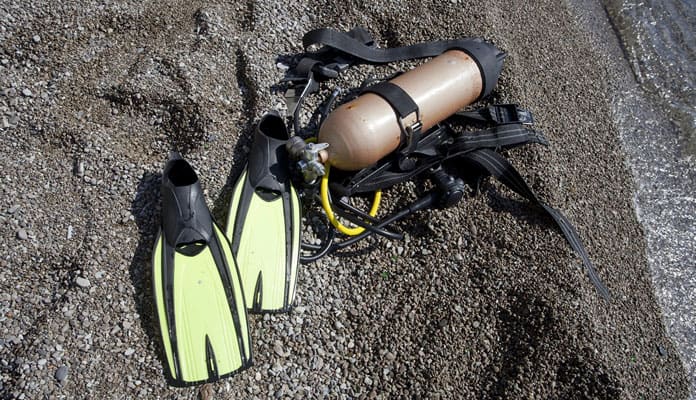
Purchasing your scuba gear is a hefty investment. Scuba gear will last years even decades before it needs to be replaced. Most beginning divers just rent their gear, until they feel comfortable that high-pressure will stay with it. Take a look at a scuba gear package you like, then divide that price by what you pay when you rent the gear. That will tell you the number of dives before you break even. Some divers never move on to investing. If you are only diving a few times each year, it may be hard to justify the investment.
Another factor that may motivate you to get your gear is muscle memory. Using the same gear each time will allow you to act without needing to think about what you have to do. Need a dump valve? Your body will know exactly where to reach.
OUR TOP PICK
Aqua Lung Pro HD BCD Scuba Package
- Stand Out Features - Why We Love It
- Aqua Lung Pro HD BCD with weight system
- Lift to 55 pounds
- Titan primary regulator
- Outstanding dive compute
Package Details:
Titan Scuba Regulator
Aqualung i300C Computer Air and Nitrox Modes
Pro HD BCD Wrap-Around Jacket With Weight Integration
ABS Octopus
EDITORS CHOICE
OCEANIC OPEN WATER SCUBA PACKAGE
- What Makes This Dive Gear Package Stand Out
- Very durable full feature BCD
- Integrate weight system
- Easy to use, powerful VEO dive computer
- Top-quality Alpha 10 regulator and Alpha 10 octopus
Package Details:
OceanPro BCD
Alpha 10 + cDX Regulator
Alpha 10 Octo
VEO 4.0 Computer
BEST VALUE
Cressi Start Pro BCD Scuba Package
- What Makes This Dive Gear Package Stand Out
- Highly durable
- Low Cost
- Dive School favorite
- Gauge package
Package Details:
Cressi Start BCD
AC2 XS regulator
XS Octopus
Mini C2 Gauge Analog Console
Cressi R1 BCD Leonardo Scuba Package
- Stand Out Features - Why We Love It
- Weight Integrated BCD
- Great stowage on the BCD
- Good quality regulators
- Air/Nitrox dive computer
Package Details:
Cressi R1 Weight Integrated BCD
Cressi Air/Nitrox Leonardo Computer Console
Cressi AC2 Compact Regulator, Yoke
Cressi Compact Octopus with Hose
Cressi Travelight Scuba
- Stand Out Features - Why We Love It
- Perfect Travel set for warm water recreational divers
- Weight integrated travel BCD
- Streamlined console with SPG and dive computer
- Travel regulators
Package Details:
Cressi Travel Light BCD
MC9 Compact Regulator Set
Octo
Leonardo C2 Console Dive Computer
Akona Less Than 7lbs Roller Suitcase
- Stand Out Features - Why We Love It
- Coldwater and technical dive package
- Best extreme cold water regulator on the market and Mil-std
- True Tech BCD
- Reliable dive computer
Package Details:
Mares Hybrid Pro Tec BC
Mares Abyss 22 Navy Regulator Yoke
Mares Air Control Alternate Air Source
Mares Puck Pro Plus Wrist Dive Computer
- Your BCD should be 100% compatible with your regulator, and often they are sold together for a discounted cost. Look for the best deal without buying low-quality equipment in conjunction with something else.
- Your octopus is your lifeline in an emergency scenario, and you should always be able to identify it underwater quickly. For this reason, octopuses are often sold with holders for quick identification.
- Your mask and snorkel go hand-in-hand, both above and below the surface. Be sure that the snorkel is easily removed and replaced with the mask you plan to use.
![]()
Scuba Diving Expert
How To Choose A Scuba Gear Package – Buying Guide
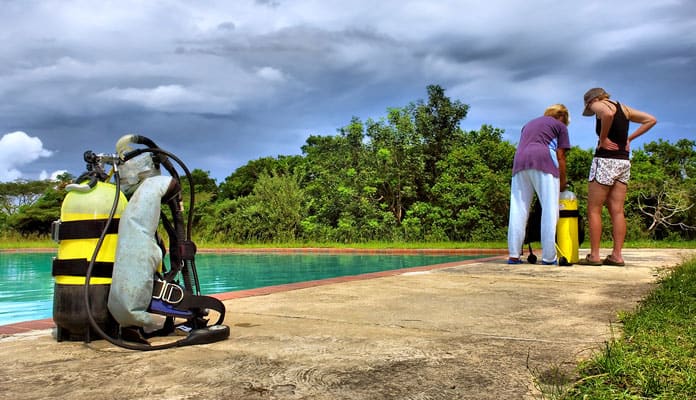
Buoyancy Control Device
While diving, we always want to control our buoyancy. In the water column, we strive to become neutral buoyancy, meaning we neither float up nor sink. We move up or down based on our body position and leg action. However, as we move deeper or shallower and as we use the air in our tanks, our buoyancy changes. The Buoyancy Control Device also called a BCD and a BC by a few manufacturers helps us make adjustments. Also, we will use the BCD to provide positive buoyancy after our dive, so we can comfortably float on the surface. The BCD is also the means we carry our air supply in a tank. A secondary function of the BCD is to help us stow our equipment. Pockets and “D” rings allow us to free our hands while still having accessories available. These are attached to the BCD. Some BCDs come with a weight integration system to remove the need for a separate weight belt.
Regulator
A regulator controls the release of the air in your dive tanks. It has two portions connected by a hose. The first stage attaches to the scuba tank. It reduces the high pressure in the tank to an intermediate pressure. The first stage has a mix of high-pressure and low-pressure ports. The high-pressure ports are used to measure the pressure remaining in the tank, while the low-pressure is used by the second stage and other low-pressure devices. The second stage is attached to the first stage by a hose. The second stage takes the air at the intermediate pressure and lowers it to the surrounding pressure. The second stage has a mouthpiece that you put in your mouth. This is the air you will breathe.
You might also like: Scuba Regulators
Octopus
The octopus is a backup second-stage regulator. It also attaches to a port on the first stage. If the primary second stage fails, a diver can switch to the octopus. Second-stage failures are very rare. However, the octopus is also seen as a sharing device. If your dive buddy runs low on air, you can share yours.
Computer
Dive computers are very popular. They have in many cases replaced the need for dive tables while planning your dives. They make real-time evaluations concerning your dive times and the risk of the bends, then inform the diver of the remaining dive time and the need for safety stops. They are also capable of recording the depth, time, and even the water temperature so you can review them later. Dive computers replace the need for a depth gauge and air-integrated ones can replace the SPG. Consider getting one with your package, it can reduce or eliminate the expense of the gauges.
FAQs
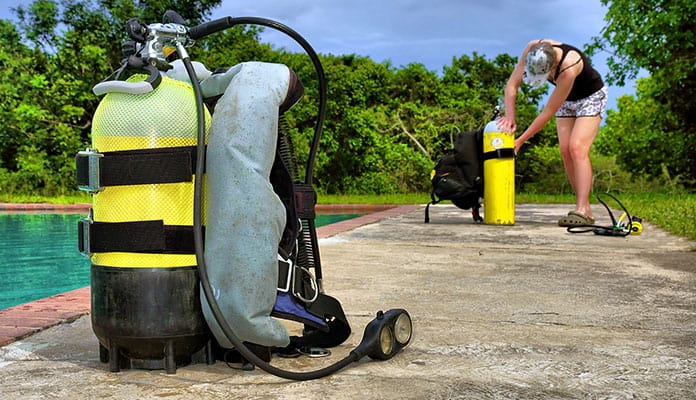
Q: What Is A Scuba Gear Package?
The scuba diving packages put together the items that you will need as you move away from rental gear to owning all of your own. Like the combo meal at your fast food restaurant, getting the items as a package will normally have some savings. Most scuba gear packages will include the BCD, regulator, octopus, and a gauge console. The 2 gauge console is the most common with a Submerged Pressure Gauge (SPG) and a depth gauge. However, as the dive computer is becoming more than a common accessory to a required item, many packages include the dive computer in the console replacing the depth gauge. Your mask, fins, and wetsuit are not a part of packages as these items are often purchased during your training.
Related Review: Dive Safety Gear
Q: Where Do I Use Scuba Gear?
Scuba diving is a very safe sport, provided that you have been properly trained. Before you go scuba diving, you must receive training and become certified. The type of scuba diving gear you choose to purchase will depend mostly on the location where you plan on diving. Warmer climates generally require less dive gear than colder climates. Commonly we refer to diving conditions into separate categories that each require a different set of gear:
Tropical or warm water Scuba Gear: In climates with water 75ºF (24ºC) or warmer you can enjoy less bulk by streamlining your gear. This includes a thin wetsuit or no suit at all.
Temperate Scuba Gear: When diving in water closer between 60 - 75ºF (15 - 24ºC) you will want some more protection. You will likely not need a thick wetsuit but one that varies depending on temperature. Having a suit around 3-5mm is ideal for these temperate environments.
Cold Water Scuba Gear: In a water cooler than 60ºF (15ºC) you will want the most protection while in the water. Keeping warm isn’t just for safety but will also make it so that you go through your air much slower. Depending on how cold your climate is, a wetsuit may not do it. You may need to opt for a dry suit. Also, at these water temperatures, you will need regulators that are designed for the colder water. Similar to the problem of icing on a plane's wing, a regulator can build up ice even when the water temperature is above freezing.
Globo Surf Overview
Scuba diving gear packages are a great way to get everything you need for your dive in one convenient place. It can be daunting to buy all the different components you will need for your dive. Opting for a full scuba gear package will ensure all your dive gear works well together and will allow you to get the most from your purchase.
More Scuba Reviews:
- Dive Camera
- Bcd For Beginners
- Full Face Scuba Mask
- Dive Watches Under 200
- Dive Watch Under 1000
- Dive Watches Under 500
- Ladies Dive Watch
- Underwater Scooter
- Scuba Regulator
- Rebreather



